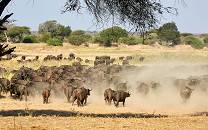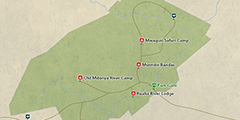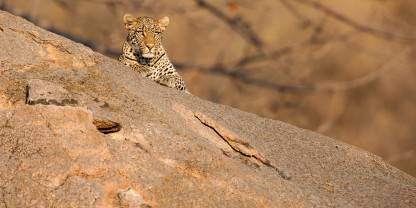Ruaha National Park is a favorite safari destination for many Africa aficionados. And that is for good reason: when it comes to a combination of wilderness appeal and diverse wildlife viewing, Ruaha is hard to beat. Its untrammeled bush vibe extends to its limited accommodation options, which mostly consist of exclusive rustic lodges and tented camps, all spread out over a vast area.

-
Best Time To Go
- June to October (Best wildlife viewing)
-
High Season
- June to October (Ruaha is rarely crowded)
-
Size
- 20,226km² / 7,809mi²
-
Altitude
-
721-1,863m /2,365-6,112ft
 View Photos
View Photos
 View Photos
+24
Photos
View Photos
+24
Photos
 Open Map
Open Map
Pros & Cons
- Top wildlife viewing in the middle and end of the Dry season
- Superb for spotting predators, including big prides of lion
- One of the best places in East Africa to encounter wild dogs
- Unusual antelope species such as greater kudu, roan and sable
- Very exclusive and it doesn't get crowded
- Tanzania’s second-largest national park (after Nyerere)
- Relatively expensive, with limited budget options
- Animals are scattered during the Wet season
- Most lodges are closed from March to May
Wildlife
Predator viewing in Ruaha is exceptional. The park is known for its big prides of lion and healthy wild dog population. While lions are very territorial, wild dogs, with their big home ranges, are a lot more elusive. The best time to see them is when they are denning. Elephants and a wide variety of antelope are another big draw to the park.
More about Ruaha's wildlifeScenery
The main geographical feature of Ruaha’s untamed wilderness is the Great Ruaha River with its sandy tributaries. Away from the river, is interspersed with dotted with ancient baobab trees and rocky outcrops.
Activities
The best way to see and photograph wildlife in Ruaha is on early morning and late afternoon . It’s also worth doing a night drive to see nocturnal animals and to marvel at the night sky. A different way to experience the wilderness is on a with an armed ranger. You’ll mostly discover tiny creatures that are not often seen from a vehicle, but you might have some thrilling encounters with big animals too.
Weather & Climate
Due to Ruaha being near the equator, temperatures don’t change much from month to month. The area is at its coolest during the Dry season (May to October), when the average afternoon temperature is around 27°C/81°F. The Wet season (November to April) is hot and humid, but it rarely rains for long.
More about the weather and climateBest Time To Visit
The heat is less intense in the Dry season (May to October). This is also when animals are attracted to the Great Ruaha River and are therefore easier to see. It can be uncomfortably hot in the wetter months, and some roads may be inaccessible at this time.
More about the best time to visit



